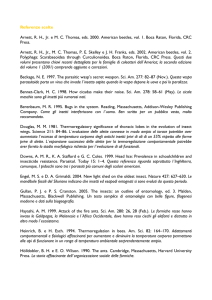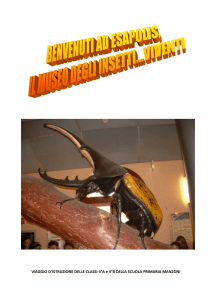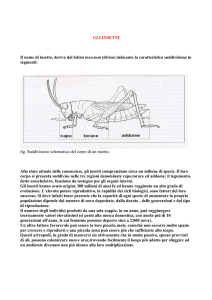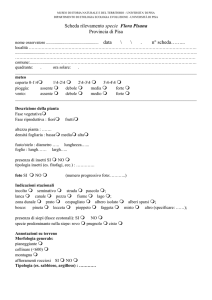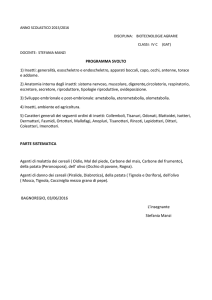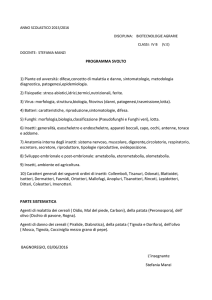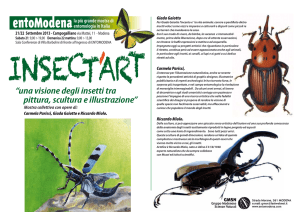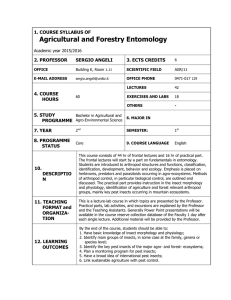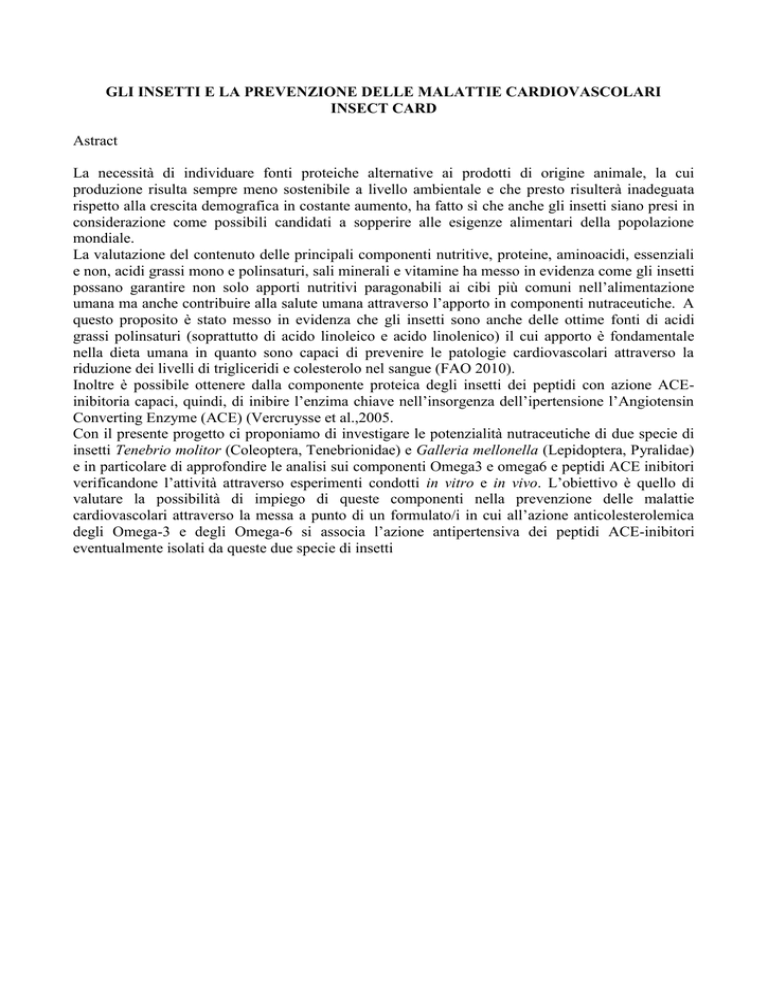
GLI INSETTI E LA PREVENZIONE DELLE MALATTIE CARDIOVASCOLARI
INSECT CARD
Astract
La necessità di individuare fonti proteiche alternative ai prodotti di origine animale, la cui
produzione risulta sempre meno sostenibile a livello ambientale e che presto risulterà inadeguata
rispetto alla crescita demografica in costante aumento, ha fatto sì che anche gli insetti siano presi in
considerazione come possibili candidati a sopperire alle esigenze alimentari della popolazione
mondiale.
La valutazione del contenuto delle principali componenti nutritive, proteine, aminoacidi, essenziali
e non, acidi grassi mono e polinsaturi, sali minerali e vitamine ha messo in evidenza come gli insetti
possano garantire non solo apporti nutritivi paragonabili ai cibi più comuni nell’alimentazione
umana ma anche contribuire alla salute umana attraverso l’apporto in componenti nutraceutiche. A
questo proposito è stato messo in evidenza che gli insetti sono anche delle ottime fonti di acidi
grassi polinsaturi (soprattutto di acido linoleico e acido linolenico) il cui apporto è fondamentale
nella dieta umana in quanto sono capaci di prevenire le patologie cardiovascolari attraverso la
riduzione dei livelli di trigliceridi e colesterolo nel sangue (FAO 2010).
Inoltre è possibile ottenere dalla componente proteica degli insetti dei peptidi con azione ACEinibitoria capaci, quindi, di inibire l’enzima chiave nell’insorgenza dell’ipertensione l’Angiotensin
Converting Enzyme (ACE) (Vercruysse et al.,2005.
Con il presente progetto ci proponiamo di investigare le potenzialità nutraceutiche di due specie di
insetti Tenebrio molitor (Coleoptera, Tenebrionidae) e Galleria mellonella (Lepidoptera, Pyralidae)
e in particolare di approfondire le analisi sui componenti Omega3 e omega6 e peptidi ACE inibitori
verificandone l’attività attraverso esperimenti condotti in vitro e in vivo. L’obiettivo è quello di
valutare la possibilità di impiego di queste componenti nella prevenzione delle malattie
cardiovascolari attraverso la messa a punto di un formulato/i in cui all’azione anticolesterolemica
degli Omega-3 e degli Omega-6 si associa l’azione antipertensiva dei peptidi ACE-inibitori
eventualmente isolati da queste due specie di insetti
The insects and the prevention of cardiovascular diseases
INSECT CARD
Abstract
The need to find alternative protein sources to animal products, whose production is less
environmentally sustainable and will soon be inadequate for the constantly human increasing
population, has meant that even the insects are considered as possible candidates to supply the food
needs of the world population.
The evaluation of the insect content of main nutritional components, proteins, essential amino acids,
mono and polyunsaturated fatty acids, minerals and vitamins has shown that they can guarantee not
only nutritional supplements comparable to common foods in the human diet, but also contribute to
human health through the nutraceutical components supplement. It was revealed that the insects are
also good sources of polyunsaturated fatty acids (mainly linoleic acid and linolenic acid) whose
intake is essential in the human diet as they are capable of preventing cardiovascular diseases
through the reduction of levels of triglycerides and cholesterol in the blood (FAO 2010)
Also it is possible to obtain some peptides from the insect protein with ACE-inhibitory action able
to inhibit the key enzyme in the onset of hypertension the Angiotensin Converting Enzyme (ACE)
(Vercruysse et al.,2005.
The aim of this project is to investigate the nutraceutical potential of two insect species Tenebrio
molitor (Coleoptera, Tenebrionidae) and Galleria mellonella (Lepidoptera, Pyralidae), in particular
focusing the analysis on Omega-3 and Omega-6 and ACE inhibitors peptides verifying its activities
through in vitro and in vivo experiments.
The objective is to evaluate the use of these components in the prevention of cardiovascular
diseases through the development of a formulation/s where the anticolesterolemic action of Omega3 and Omega-6 is joined with the antihypertensive action peptides ACE inhibitors isolated from
these two species of insects


